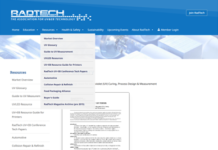When the UV+EB Technology editorial team did a review of the most popular articles from 2023, Professor Byron Christmas’s article from Q1 2023 on free radical polymerization kinetics was a leader of the pack. As often is the case, this led the editorial team down a rabbit hole to investigate which other Professor’s Corner columns were hits, and it quickly became apparent that there is a large group of magazine readers that is curious about the scientific principles governing the use of UV curing technology. In this edition of the Professor’s Corner, readers can revisit the most-read columns from the last several years.
Free Radical Polymerization Kinetics
Issue 1, 2023
UV/EB polymerization involves chain-growth polymerization kinetics. This includes both free radical and cationic processes. In this edition of Professor’s Corner, an introduction to free radical polymerization kinetics will be presented. This field of polymer science is concerned with the rate or “speed” of polymerization reactions and the factors that affect the rate. A study of kinetics leads to the development of proposed reaction mechanisms that explain how reactants move, step-by-step, toward products at the molecular scale. It is important to note, however, that reaction mechanisms are formal hypotheses which may be demonstrated to be incorrect with subsequent experimentation. A well-established mechanistic hypothesis for free radical polymerization involves at least three steps or phases: Initiation, Propagation and Termination. Some specific reactions also may involve a fourth step: Chain-Transfer.
Read more: https://uvebtech.com/articles/2023/free-radical-polymerization-kinetics/
Terminology Clarification
Issue 2, 2023
People entering the polymer technical workforce are immediately confronted with a wide range of terms and definitions, many of which are used interchangeably. It may be useful to confront this linguistic issue directly, and perhaps a good place to start is with the words ‘curable,’ ‘cured’ or ‘curing,’ as in ‘UV-curable,’ ‘energy-cured’ or ‘radiation curing.’ When a polymer is ‘cured,’ a linear or branched polymeric species is subjected to a subsequent chemical process wherein the macromolecules are linked together by covalent bonds. The terminology comes from traditional conventional thermal or air curing processes. However, this is not typically what happens with UV or EB ‘curing.’ Rather, in most cases, a mixture of non-polymeric oligomers and monomers of relatively low molecular mass are coated or printed onto a substrate and, subsequently, they are polymerized and cross-linked (cured) simultaneously. While this is not a critical linguistic issue, it is, perhaps, more accurate to suggest the terms ‘UV polymerization,’ ‘EB polymerization’ or ‘energy polymerization’ be used to describe the process.
Read more: https://uvebtech.com/articles/2023/terminology-clarification/
Understanding Polymer Properties with Intermolecular Attractive Forces – Part 1
Issue 4, 2021
For solids and liquids to exist at all, gaseous species must have the inherent ability to attract one another strongly enough to condense into liquids and solids. Relatively low-molecular-mass materials can exist in all three states of matter, but polymers typically exist only as liquids and solids. This fact indicates that the total forces of attraction among polymer macromolecules are very strong indeed. Were one to attempt to evaporate a polymeric liquid or sublime a polymeric solid by lowering the pressure and raising the temperature, decomposition would occur well before any intact macromolecules could break free from the bulk liquid or solid to become independent gaseous species. Also, many solid polymers (including all cross-linked polymers) exhibit sufficiently strong intermolecular attractions that decomposition occurs before they can be melted. A review of these intermolecular forces of attraction is, therefore, in order.
Adhesion and Energy-Curable Coatings
Issue 4, 2022
Adhesion, or lack of it, is one of the most critical attributes for most coatings, inks and, of course, adhesives themselves. While the concept of adhesion may sound simple, the details can be more complex. A key factor for most types of adhesive bonding is substrate wetting, which refers to whether the coating flows over the substrate or whether it “beads up.” If the coating or ink does not fully cover the surface of the substrate, then the adhesion will be limited by the diminished contact area. There are several ways a formulator can affect the wetting out of the formulation on the surface of the substrate. These methods can be summarized in the relationship between substrate surface energy and coating surface tension.
Read more: https://uvebtech.com/articles/2022/adhesion-and-energy-curable-coatings/
Intermolecular Attractive Forces: The Key to Understanding Polymer Properties, Part 2
Issue 1, 2022
In this edition of “Professor’s Corner,” a discussion of Intermolecular Attractive Forces is continued. In Part 11, the subject was introduced, and London Dispersion Forces (LDFs) were discussed. These are the forces of attraction exhibited by all atomic, ionic or molecular materials, even those that are completely non-polar. In this edition, we will look at the attractive forces present in polymers that are polar – those that have a permanent charge separation within the macromolecules. These attractive forces are known as “dipole-dipole attractions.” The negative end of one dipole is attracted to the positive end of another. These attractions can be between polar groups on separate molecules or, in the case of polymers, they can be intramolecular due to the long chains folding back on themselves.
Technical Questions?
What are your technical questions about polymer science, photopolymerization or other topics concerning the chemistry and technology of UV/EB polymerization? Please submit your questions or comments via e-mail to Dianna Brodine, vice president, Editorial, Peterson Media Group, at dianna@petersonmg.com or to Professor Byron Christmas at b4christmas@gmail.com.
 Byron K. Christmas, Ph.D.
Byron K. Christmas, Ph.D.
Professor of Chemistry, Emeritus
University of Houston-Downtown
b4christmas@gmail.com





